Seats Acura TL 2000 3.2 User Guide
[x] Cancel search | Manufacturer: ACURA, Model Year: 2000, Model line: TL, Model: Acura TL 2000Pages: 311, PDF Size: 3.05 MB
Page 27 of 311
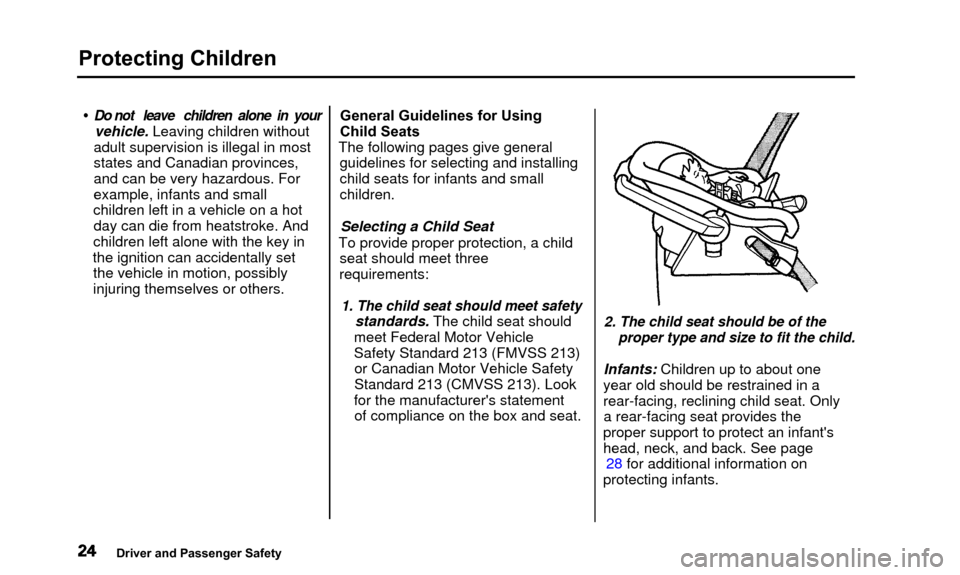
Protecting Children
• Do not leave children alone in your
vehicle. Leaving children without
adult supervision is illegal in most
states and Canadian provinces,
and can be very hazardous. For
example, infants and small
children left in a vehicle on a hot day can die from heatstroke. And
children left alone with the key in
the ignition can accidentally set the vehicle in motion, possibly
injuring themselves or others. General Guidelines for Using
Child Seats
The following pages give general guidelines for selecting and installing
child seats for infants and smallchildren.
Selecting a Child Seat
To provide proper protection, a child seat should meet three
requirements:
1. The child seat should meet safety
standards. The child seat should
meet Federal Motor Vehicle
Safety Standard 213 (FMVSS 213) or Canadian Motor Vehicle Safety
Standard 213 (CMVSS 213). Look
for the manufacturer's statement of compliance on the box and seat.2. The child seat should be of the proper type and size to fit the child.
Infants: Children up to about one
year old should be restrained in a
rear-facing, reclining child seat. Only a rear-facing seat provides the
proper support to protect an infant's
head, neck, and back. See page 28 for additional information on
protecting infants.
Driver and Passenger Safety
Page 28 of 311
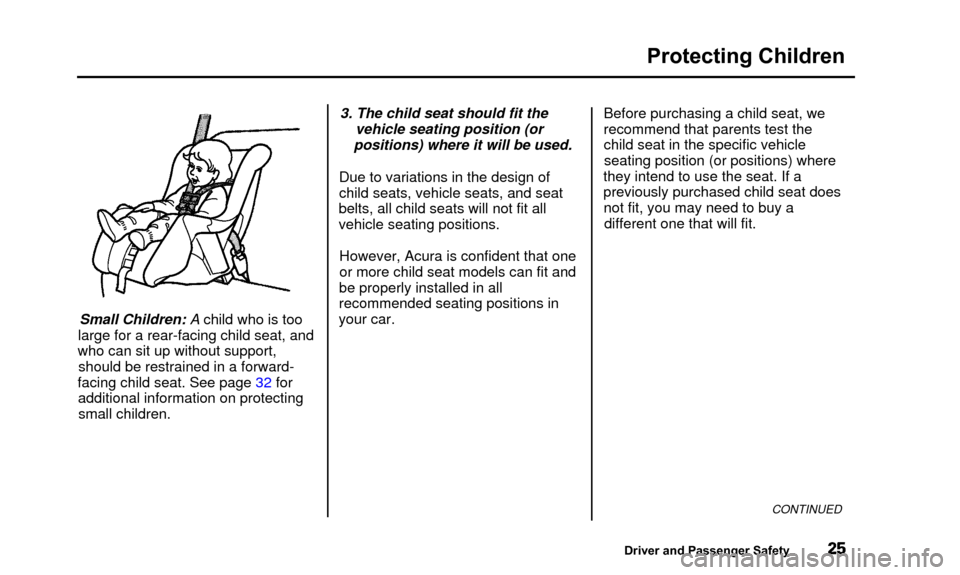
Protecting Children
Small Children: A child who is too
large for a rear-facing child seat, and
who can sit up without support, should be restrained in a forward-
facing child seat. See page 32 for additional information on protectingsmall children. 3. The child seat should fit the
vehicle seating position (or
positions) where it will be used.
Due to variations in the design of
child seats, vehicle seats, and seat
belts, all child seats will not fit all vehicle seating positions.
However, Acura is confident that one
or more child seat models can fit and
be properly installed in all
recommended seating positions in
your car. Before purchasing a child seat, we
recommend that parents test the
child seat in the specific vehicle
seating position (or positions) where
they intend to use the seat. If a
previously purchased child seat does not fit, you may need to buy a different one that will fit.
CONTINUED
Driver and Passenger Safety
Page 29 of 311
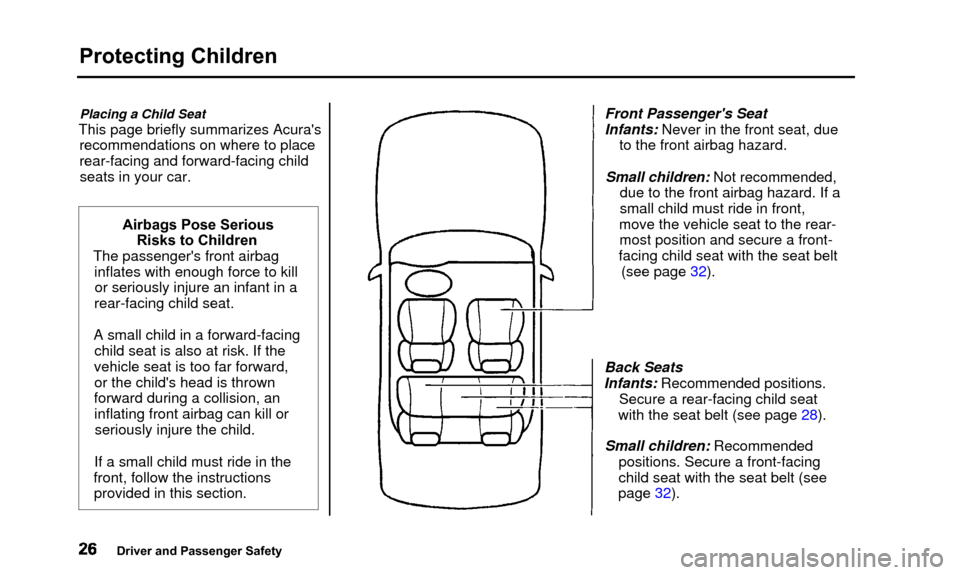
Protecting Children
Placing a Child Seat
This page briefly summarizes Acura'srecommendations on where to place
rear-facing and forward-facing childseats in your car.
Airbags Pose SeriousRisks to Children
The passenger's front airbag inflates with enough force to killor seriously injure an infant in a
rear-facing child seat.
A small child in a forward-facing child seat is also at risk. If the
vehicle seat is too far forward, or the child's head is thrown
forward during a collision, an inflating front airbag can kill orseriously injure the child.
If a small child must ride in the
front, follow the instructions provided in this section. Front Passenger's Seat
Infants: Never in the front seat, due
to the front airbag hazard.
Small children: Not recommended,
due to the front airbag hazard. If a
small child must ride in front,
move the vehicle seat to the rear- most position and secure a front-
facing child seat with the seat belt (see page 32).
Back Seats
Infants: Recommended positions. Secure a rear-facing child seat
with the seat belt (see page 28).
Small children: Recommended positions. Secure a front-facing
child seat with the seat belt (see
page 32).
Driver and Passenger Safety
Page 30 of 311

Protecting Children
Installing a Child Seat
After selecting a proper child seat, and a good position to install the seat,
there are three main steps in installing the seat:
1. Secure the child seat to the car with a seat belt. All child seats
must be secured to the car with
the lap part of a lap/shoulder belt.
A child whose seat is not properly secured to the car can be
endangered in a crash. See pages 29 and 33 for instructions on how
to secure child seats in this car.
2. Make sure the child seat is firmly secured. After installing a childseat, push and pull the seat
forward and from side to side to
verify that it is secure. To provide security during normal
driving maneuvers as well as during
a collision, we recommend that
parents secure a child seat as firmly as possible.
However, a child seat does not need
to be "rock solid." In some vehicles or seating positions, it may be
difficult to install a child seat so that
it does not move at all. Some side-to-side or back-and-forth movement can
be expected and should not reduce the child seat's effectiveness.
If the child seat is not secure, try
installing it in a different seating
position, or use a different style of
child seat that can be firmly secured
in the desired seating position. 3. Secure the child in the child seat.
Make sure the child is properly
strapped in the child seat
according to the child seat maker's
instructions. A child who is not
properly secured in a child seat
can be thrown out of the seat in a
crash and seriously injured.
Storing a Child Seat
When you are not using a child seat, either remove it and store it in a safe
place, or make sure it is properly secured. An unsecured child seat can
be thrown around the car during a
crash or sudden stop and injure
someone.
Driver and Passenger Safety
Page 31 of 311
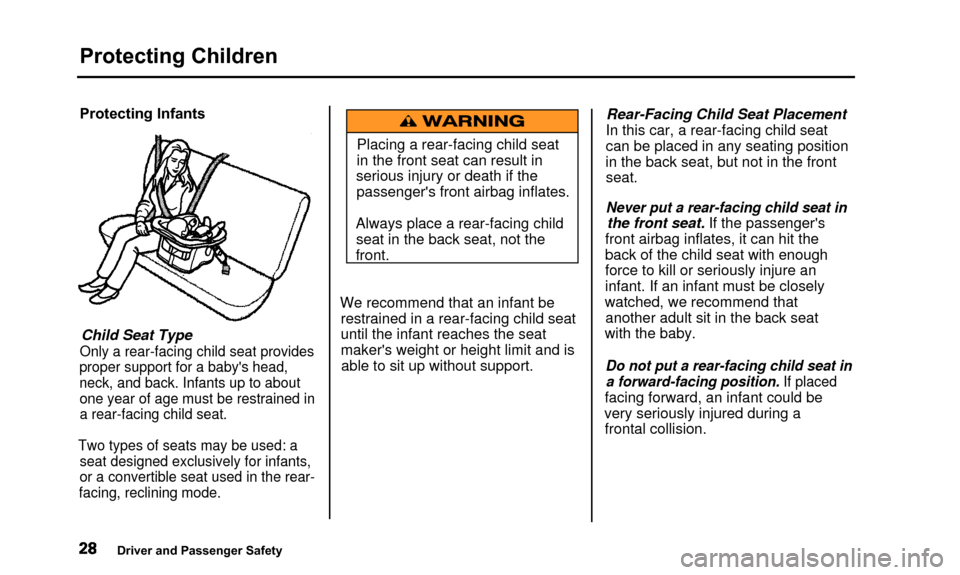
Protecting Children
Protecting InfantsChild Seat Type
Only a rear-facing child seat provides
proper support for a baby's head,
neck, and back. Infants up to about one year of age must be restrained in
a rear-facing child seat.
Two types of seats may be used: a seat designed exclusively for infants,
or a convertible seat used in the rear-
facing, reclining mode.
Placing a rear-facing child seat
in the front seat can result in
serious injury or death if the passenger's front airbag inflates.
Always place a rear-facing child seat in the back seat, not the
front.
We recommend that an infant be restrained in a rear-facing child seat
until the infant reaches the seat
maker's weight or height limit and isable to sit up without support. Rear-Facing Child Seat Placement
In this car, a rear-facing child seat
can be placed in any seating position
in the back seat, but not in the front seat.
Never put a rear-facing child seat in
the front seat. If the passenger's
front airbag inflates, it can hit the
back of the child seat with enough
force to kill or seriously injure an
infant. If an infant must be closely
watched, we recommend that another adult sit in the back seat
with the baby.
Do not put a rear-facing child seat in a forward-facing position. If placed
facing forward, an infant could be
very seriously injured during a frontal collision.
Driver and Passenger Safety
Page 32 of 311
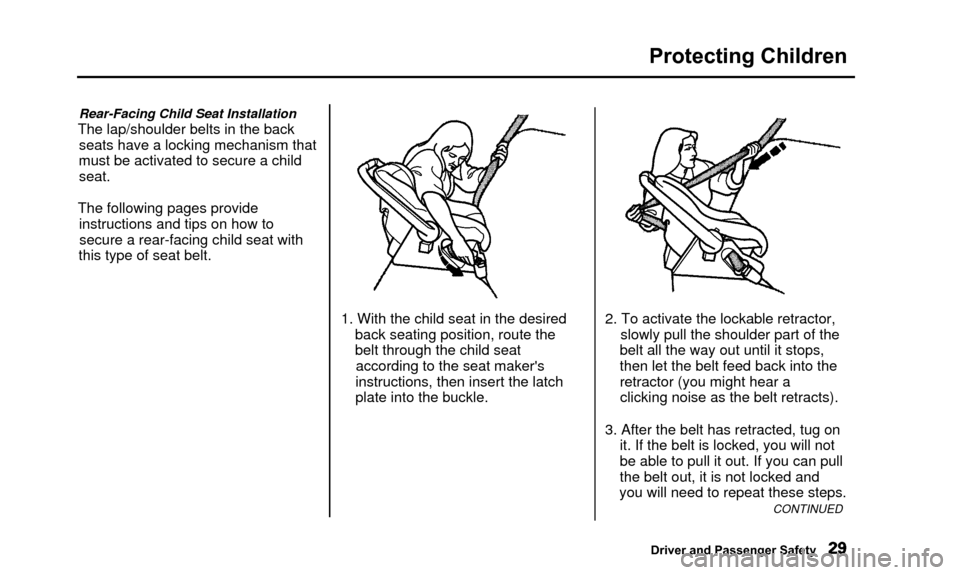
Protecting Children
Rear-Facing Child Seat Installation
The lap/shoulder belts in the backseats have a locking mechanism that
must be activated to secure a child seat.
The following pages provide instructions and tips on how tosecure a rear-facing child seat with
this type of seat belt.
1. With the child seat in the desiredback seating position, route the
belt through the child seataccording to the seat maker's
instructions, then insert the latch
plate into the buckle. 2. To activate the lockable retractor,
slowly pull the shoulder part of the
belt all the way out until it stops,
then let the belt feed back into the
retractor (you might hear a clicking noise as the belt retracts).
3. After the belt has retracted, tug on it. If the belt is locked, you will not
be able to pull it out. If you can pull
the belt out, it is not locked and
you will need to repeat these steps.
CONTINUED
Driver and Passenger Safety
Page 35 of 311

Protecting Children
Protecting Small Children
Child Seat Type A child who can sit up without support, and who fits within the childseat maker's weight and height
limits, should be restrained in a
forward-facing, upright child seat.
Of the different seats available, we
recommend those that have a five-
point harness system as shown. We also recommend that a small
child stay in the child seat as long as
possible, until the child reaches the
weight or height limit for the seat.
Child Seat Placement
In this car, the best place to install a
forward-facing child seat is in one of
the seating positions in the back seat.
Placing a forward-facing child seat in
the front seat of a vehicle equipped
with a passenger's front airbag can
be hazardous. If the vehicle seat is
too far forward, or the child's head is
thrown forward during a collision, an inflating front airbag can strike the
child with enough force to cause
very serious or fatal injuries. If a small child must be closely watched,
we recommend that another adult sit in the back seat with the child. Improperly placing a forward-
facing child seat in the front
seat can result in serious injury or death if the front airbags inflate.
If you must place a forward-
facing child seat in front, move
the vehicle seat as far back as possible and properly restrain
the child.
If it is necessary to put a forward-
facing child seat in the front, move
the vehicle seat as far to the rear as
possible, be sure the child seat is
firmly secured to the car, and the child is properly strapped in the seat.
Driver and Passenger Safety
Page 42 of 311
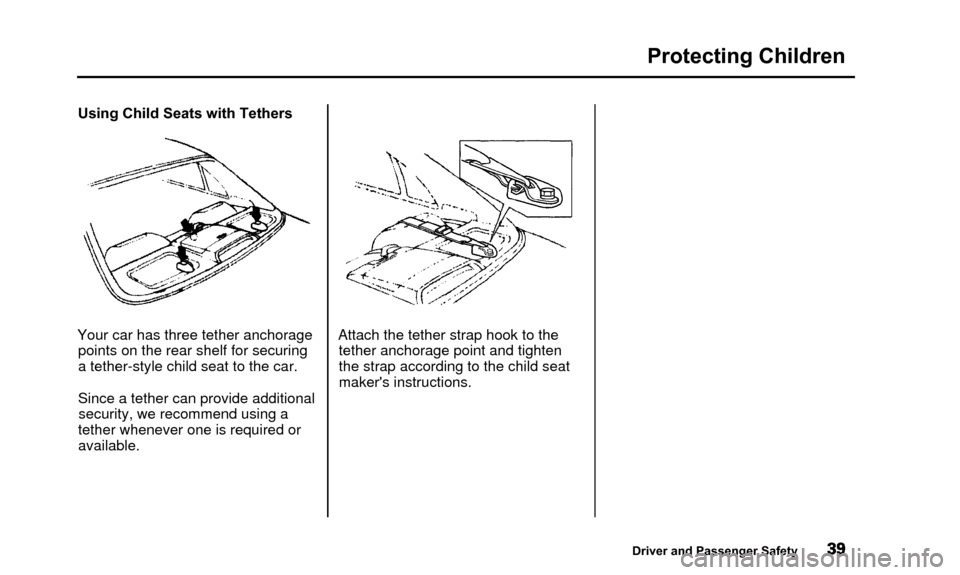
Protecting Children
Using Child Seats with Tethers
Your car has three tether anchorage points on the rear shelf for securing
a tether-style child seat to the car.
Since a tether can provide additionalsecurity, we recommend using a
tether whenever one is required or available. Attach the tether strap hook to the
tether anchorage point and tighten
the strap according to the child seat
maker's instructions.
Driver and Passenger Safety
Page 44 of 311
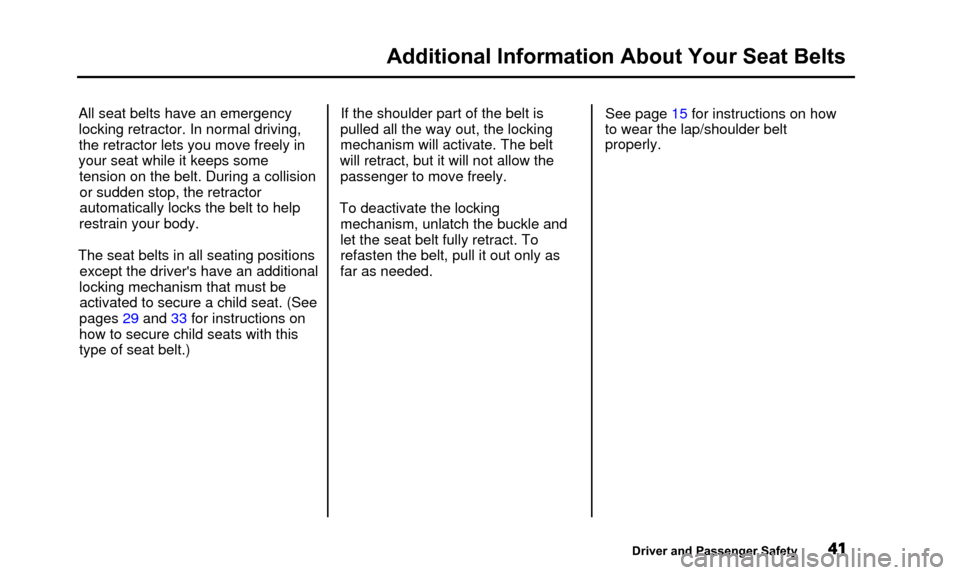
Additional Information About Your Seat Belts
All seat belts have an emergencylocking retractor. In normal driving,
the retractor lets you move freely in
your seat while it keeps some tension on the belt. During a collisionor sudden stop, the retractor
automatically locks the belt to help
restrain your body.
The seat belts in all seating positions except the driver's have an additional
locking mechanism that must be activated to secure a child seat. (See
pages 29 and 33 for instructions on
how to secure child seats with this type of seat belt.) If the shoulder part of the belt is
pulled all the way out, the locking
mechanism will activate. The belt
will retract, but it will not allow the passenger to move freely.
To deactivate the locking mechanism, unlatch the buckle and
let the seat belt fully retract. To
refasten the belt, pull it out only as
far as needed. See page 15 for instructions on how
to wear the lap/shoulder belt
properly.
Driver and Passenger Safety
Page 49 of 311
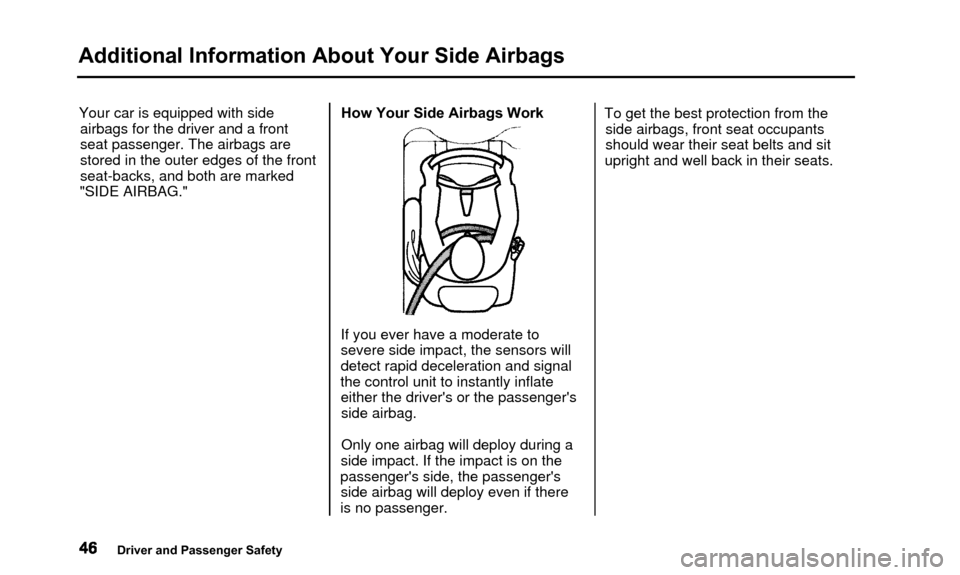
Additional Information About Your Side Airbags
Your car is equipped with sideairbags for the driver and a front
seat passenger. The airbags are
stored in the outer edges of the front
seat-backs, and both are marked
"SIDE AIRBAG." How Your Side Airbags Work
If you ever have a moderate to
severe side impact, the sensors will
detect rapid deceleration and signal
the control unit to instantly inflate either the driver's or the passenger'sside airbag.
Only one airbag will deploy during a
side impact. If the impact is on the
passenger's side, the passenger's side airbag will deploy even if there
is no passenger. To get the best protection from the
side airbags, front seat occupants
should wear their seat belts and sit
upright and well back in their seats.
Driver and Passenger Safety